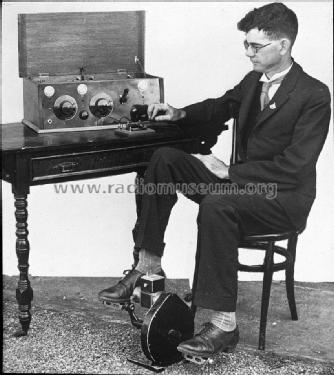Pedal Wireless Baby
Traeger Transceivers Pty. Ltd.; Adelaide
- Paese
- Australien
- Produttore / Marca
- Traeger Transceivers Pty. Ltd.; Adelaide
- Anno
- 1928
- Categoria
- Kommerzieller Sender & Empfänger (TRX nicht Amateur)
- Radiomuseum.org ID
- 275691
- Numero di tubi
- 3
- Principio generale
- Geradeaus allg. (mit oder ohne Rückk.)
- Gamme d'onda
- Mittelwelle und Kurzwelle.
- Tensioni di funzionamento
- Batterien / Niedervolt Stromversorgung (power jack) / 2 × 1.5 & 9 or 180 Volt
- Lautsprecher
- - nur für Ohrhörer!
- Material
- Gerät mit Holzgehäuse
- Radiomuseum.org
- Modello: Pedal Wireless Baby - Traeger Transceivers Pty. Ltd.
- Form
- Tischgerät-gross, - Querformat (breiter als hoch oder quadratisch).
- Annotazioni
-
Alf Taeger with help from Harry Kauper built the first Pedal Transceiver in 1928 and the first practical test took place in November. Six Pedal Wirelesses were built in 1929, for the Air Medical service, the predecessor to the Royal flying Doctor Service.
The transceiver used a B205 triode as a crystal oscillator, output stage with an RF output of 1.5 W.
It transmitted Morse code on a frequency of 2230 kHz. Morse was used because voice transmission was not practical at the time due to the higher power consumption required. Low power battery valves suitable for voice transmission did not become available till mid-1930’s.
The 2 valve regenerative receiver used two A141 tetrodes. The receiver covered the broadcast band up to approximately 4 MHz.
The filament supply was from two 1.5 V dry batteries and one 9 V battery. Treager developed a pedal generator to supply the B+ producing 180 V.
Silicon Chip magazine of November 2010 describes a replica of this radio built by John Sheard.
- Bibliografia
- Silicon Chip magazine, November 2010, Page 98
- Autore
- Modello inviato da Gary Cowans. Utilizzare "Proponi modifica" per inviare ulteriori dati.
- Altri modelli
-
In questo link sono elencati 6 modelli, di cui 4 con immagini e 1 con schemi.
Elenco delle radio e altri apparecchi della Traeger Transceivers Pty. Ltd.; Adelaide
Letteratura
Il modello Pedal Wireless è documentato nella seguente letteratura.

